
On February 19, 1878, Thomas Edison received a patent for the phonograph.
The photo shows Thomas Edison with his patented phonograph.The device could mechanically record and reproduce sound. In its later forms, the device was called gramophone. While other inventors had produced devices that could record sounds, Edison’s phonograph was the first to be able to reproduce the recorded sound.
The sound vibration waveforms are recorded as corresponding physical deviations of a spiral groove engraved, etched, incised, or impressed into the surface of a rotating cylinder or disc, called a “record”. To recreate the sound, the surface is similarly rotated while a playback stylus traces the groove and is therefore vibrated by it, very faintly reproducing the recorded sound. In early acoustic phonographs, the stylus vibrated a diaphragm which produced sound waves which were coupled to the open air through a flaring horn, or directly to the listener’s ears through stethoscope-type earphones.

The disc phonograph record was the dominant audio recording format throughout most of the 20th century. From the mid-1980s, phonograph use declined sharply because of the rise of the compact disc and other digital recording formats.
Source: Wikipedia
Patent Information
Publication number: US200521 A
Patent Title: Improvement in phonograph or speaking machines
Publication type: Grant
Publication date: 19 Feb 1878
Filing date: 24 Dec 1877
